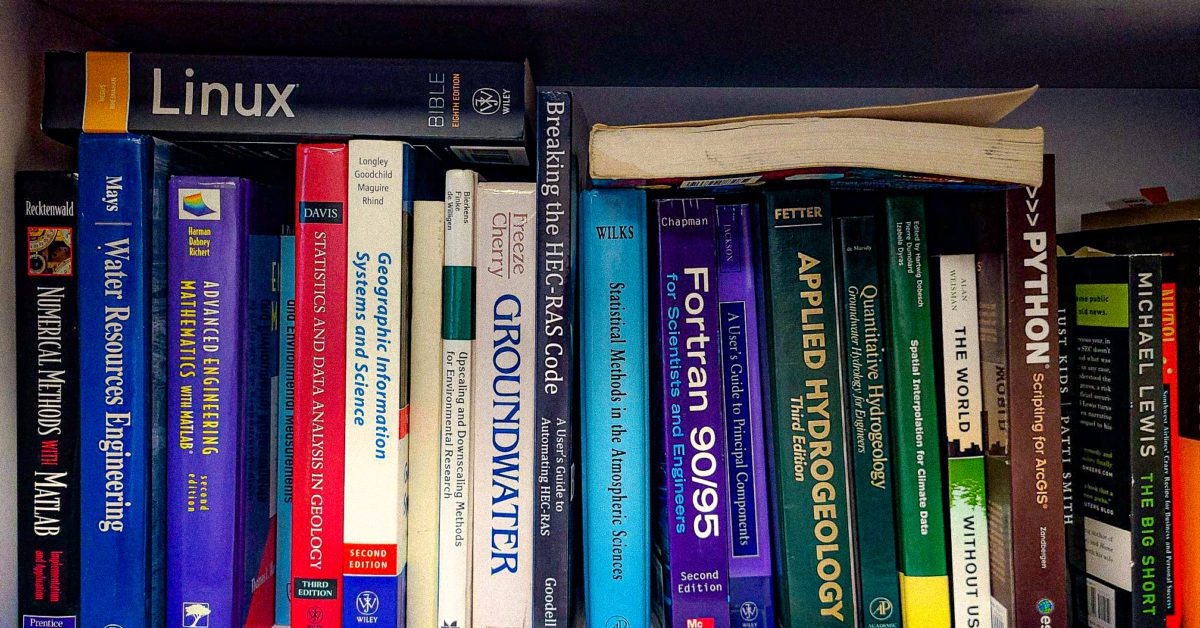No matter whether you’re new to the field of civil engineering or you’ve been working in it for decades, every civil engineer knows that it’s essential to continue expanding your knowledge about the industry. Becoming an expert begins with taking the right civil engineering courses in college, but after that, it’s still important to immerse yourself in the subject through books.
In pursuit of continued learning, we’ve put together a list of 11 of our favorite books about civil engineering. Some are better for pleasure reading while others are more textbook-style, but all of them are sure to offer you a rich deep dive into whatever subject you choose to explore.
The field of civil engineering is always evolving, so it’s important to stay up on your knowledge and make sure you remain an expert. It’s never a bad day to pick up a book about civil engineering. Once you start reading one of our top picks, you’re sure to be hooked.

via Unsplash
The Best Civil Engineering Books
Whatever topic you’re looking to explore, our top book selections for civil engineers are sure to offer you an interesting inroad to this type of reading. It’s especially important to take a look at these books if you’re a novice civil engineer. Pour yourself a cup of tea, sit down in your favorite comfortable chair, and start turning those pages.
Structures: Or Why Things Don’t Fall Down by J.E. Gordon
Have you ever wondered how suspension bridges don’t collapse under the weight of eight lanes of rushing traffic? What about how dams manage to hold back thousands of gallons of water? How do skyscrapers not simply topple in the wind?
If you’ve ever wondered about these topics, Structures: Or Why Things Don’t Fall Down is an excellent, readable work on structural engineering. J.E. Gordon is a British material scientist who wanted to write a work that was free of technical jargon and full of wit and humor. Still, it’s an unparalleled primer on the topics of structural design.
It’s also worth noting that this book was on Business Insider’s list of “14 Books that Inspired Elon Musk.” In other words, it’s a must-read for every engineer out there.
The Tower and the Bridge: The New Art of Structural Engineering by David P. Billington
In Billington’s popular text, he discusses the overlap between structural engineering and art. He emphasizes the way that great structures not only need to overcome technical challenges but also can achieve the status of art. For example, think of the Eiffel Tower or the Brooklyn Bridge. Those are just two of the highly recognizable examples that Billington covers.
The book includes many beautiful photographs and illustrations. It covers the concrete roofs of Italian engineer Pier Luigi Nervi, as well as the works of leading engineers and artists like Othmar Ammann, Flex Candela, Gustave Eiffel, Fazlur Khan, Robert Maillart, John Roebling, and plenty more. The Tower and the Bridge is an excellent inspiration for all that civil engineering can be when it’s at its best.

via Unsplash
Advances in Water Resource Engineering by Chih Ted Yang and Lawrence K. Wang
In their co-authored book, Yang and Wang compile numerous resources that both students and professionals can use to learn about the theories related to water resource systems. This is an especially useful text for those looking to go into the field of water resource engineering or work on environmental projects where water is often a factor.
Advances in Water Resource Engineering covers topics like watershed dynamics and modeling, reservoir sedimentation, integrated simulation of interactive surface water, fluvial processes, river channel stabilizations, hydraulic modeling development, soil erosion, and more. It’s certainly a specialized text, but for the right reader, it will be incredibly informative.
Strength of Materials: Mechanics of Solids by R.S. Khurmi
One important niche of civil engineering is materials—how much weight can they support? What can they hold? At what point will they break under pressure? In Strength of Materials, author R.S. Khurmi answers these questions and more.
He even explores how the strength and flexibility characteristics of materials are determined in a lab, and provides illustrative real-world examples to color his narrative.
Khurmi breaks down the tests that are commonly used to observe and measure the effects of certain forces on each component material. He covers the mechanics of materials in great depth, defining the methods through which scientists determine the strength, stiffness, and stability of any given material.
Although this science may seem complicated, the book includes many detailed graphics that can help readers grasp the important concepts. Plus, properly distributing load and understanding the properties of load-bearing materials is a crucial part of safe and efficient civil engineering processes. For that reason, this book is essential reading for novices and experienced civil engineers alike.
Why Buildings Fall Down: How Structures Fail by Matthys Levy and Mario Salvadori
A follow-up to Mario Salvadori’s first book, Why Buildings Stand Up: The Strength of Architecture, this work focuses on the many ways in which structures can fall. Salvadori and his co-author Levy are both structural engineers, and in this text, they explore a series of case studies and examples of structural failure ranging from ancient times to the present day.
Among their examples are the failures of ancient domes like Istanbul’s Hagia Sophia Grand Mosque and the 1978 collapse of the modern Hartford Civic Center in Connecticut. The book also includes details about the destruction of the Roman Pantheon and earthquake damage in Armenia and San Francisco.
For each example that Levy and Salvadori cover, they discuss why the failure occurred and what we can learn from it. Though not necessarily an uplifting topic, this book is an essential piece of reading for any engineer committed to preventing themselves and others in the field from repeating past mistakes.
Craig’s Soil Mechanics by J.A. Knappett and R.F. Craig
Craig’s Soil Mechanics is one of the definitive texts read by civil engineering students around the globe. To attest to its popularity and prevalence, we should probably mention that it’s already in its ninth edition. It continues to evolve and grow, with each edition of the text adding new chapters and extended and updated sections that keep Craig’s Soil Mechanics a perennial favorite.
The book covers fundamental soil mechanics and their applications in applied geotechnical engineering. The text is written at a level appropriate for an undergraduate civil engineer, but it also has plenty of extension materials that can be used for masters-level courses. It’s not just for students though. Craig’s Soil Mechanics is a helpful reference for any engineer.
As a bonus, it’s chock full of practical examples and it comes with a suite of digital tools and references. For those reasons, it’s a good one to keep on hand no matter where you are in the course of your civil engineering career.
Environmental Engineering by Howard S. Peavy and Donald Rowe
Initially published in 1985, Environmental Engineering has remained a classic for a reason. It unites three principal areas of environmental engineering: water, air, and solid waste management. Upon its publication, the text was revolutionary for its unique approach, in which it emphasized the relationship between the principles of natural purification processes and those used in manually engineered systems.
Environmental Engineering covers the physical, mathematical, biological, and chemical principles that are used to define, measure, and quantify environmental quality. These foundational principles are the core of many modern environmental practices, and understanding them is crucial to anyone who wants to specialize in that field.
The book is written in a clear style that’s accessible to many different readers. It also offers an abundance of illustrations and example problems to help readers understand and retain the prolific content that it offers.
Chemistry for Environmental Engineering and Science by Clair Sawyer, Perry McCarty, and Gene Parkin
This text is popular among senior and graduate-level civil engineering students who have a focus on environmental engineering and are taking a chemistry course. It’s especially useful because it’s divided into two parts: one on chemistry fundamentals and another on water and wastewater analysis. This twofold structure makes it more broadly appealing.
The basic chemical principles covered by Sawyer, McCarty, and Parkin include general, physical, equilibrium, organic, bio, colloid, and nuclear chemistry. These aspects of chemistry are described in a way that lends itself to applications involving environmental and engineering problems that are relevant to real careers in these fields.
The New Carbon Architecture: Building to Cool the Planet by Bruce King
Originally published in 2017, King’s work is one of the more recent additions to this list. According to King, “green buildings” that cut energy use and carbon emissions are all the rage, but they aren’t actually doing enough to mitigate the problem of climate change. Instead, King offers a descriptive catalog of the ways in which we can build to actually make a difference in our planet’s health and longevity.
With the built environment set to double by 2030, buildings and their materials (in terms of mining, manufacturing, and transportation) are a huge emissions source that threatens to overwhelm the climate. King’s book proposes solutions to this problem, offering a “paradigm-shifting” tour of architectural and construction innovations that allow for change.
If you’re looking to make your civil engineering career even more impactful, pick up The New Carbon Architecture. This inspiring work is sure to fuel the imaginations of architects, builders, engineers, and policymakers alike. Essentially, anyone who’s interested in healing our climate will enjoy this book.

via Unsplash
Structural Engineer’s Pocket Book by Fiona Cobb
While it’s small in size, Cobb’s Structural Engineer’s Pocket Book is huge in scope, and it’s incredibly useful. The text compiles tables, data, facts, and formulas that structural and civil engineers need on a day-to-day basis. It’s an important resource to have on hand and once you get it, you won’t be able to live without it.
Plus, it’s an affordable way to get all the facts and figures you need in one place. The book includes 14 sections including subjects like geotechnics, structural steel, reinforced concrete, masonry, and timber. While you might not want to sit down and read this one for pleasure, you’ll swear by it as your closest ally in the field.
The Civil Engineering Handbook by W.F. Chen, edited by J.Y. Richard Liew
Dr. Wai-Fah Chen, author of The Civil Engineering Handbook, is a famous name when it comes to the civil engineering community. He’s been lauded as one of the industry’s leading innovators for more than half a century, and he’s headed several collegiate engineering departments, sharing his wisdom with the new generation.
The Civil Engineering Handbook offers a high-level evaluation of three important aspects of engineering: theoretical, practical, and computational. The book also gives its readers many illustrative resources like tables, charts, and equations that can help them become increasingly competent in the field of civil engineering.
This book is a dense read, but it provides a comprehensive overview of both traditional and innovative approaches to analysis and design. For any reader, it’s sure to advance knowledge in the industry and spur creative thinking.
Final Thoughts
Maintaining a robust library of civil engineering books is crucial to anyone who aims to be an expert in the field. Whether you choose to dive deeper into your own interests and subspecialty or explore one that you’re not as experienced in, these 11 civil engineering books are the best in the game. You’re sure to learn something new.
Continuous education is essential in an ever-evolving field like civil engineering. Professionals who excel in their jobs within this industry need to ensure they’re always up to date on the latest developments. Consuming books written by experts as well as civil engineering news sources is an excellent way to accomplish this goal.





